CHAPTER 23
A Move to “The Bronx”
Rents in New York City were becoming astronomical. Many people were
leaving Manhattan for the outer Burroughs; Brooklyn, Queens, The
Bronx, where rents were considerably lower.
At Southgate Tower it had been steadily increasing every year. I
was not only paying that rent, but for two years had been paying
rent for an Indianapolis apartment as well. Now that I was no longer
receiving an income it had become unbearable.
The apartment I moved to in the Bronx was in an Italian
neighborhood, close to the magnificent Bronx Zoo and Botanical
Gardens, a sanctuary in the midst of what was less than a perfect
environment. I went there a lot, between weekly visits to the
un-employment office.
My unemployment didn’t last long. During August, just as I turned
53, I wrote a letter to Nikita Talin, the new director of Harkness
House, to see if it might be possible to return, this time as a
teacher.
Harkness House was no longer the whirlwind of activity it had
been before, filled with creative people. The company had long ago
disbanded. David Howard, the reigning force in the trainee program
had left, along with his co-director Maria Veigh. David had opened
his own studio on Manhattan’s West side near Lincoln Center and was
becoming a much-adored master teacher. Veigh had left for California
where she got a teaching job, possibly through claiming credits for
the Cinderella and Sleeping Beauty that I had staged for her.
Both had been rude and arrogant to me in the past. I guess it’s
the nature of the game in the dance profession, as in corporate
business, to step over those who appear less aggressive.
“Bobby” Scevers and Nikita Talin ran what was left of the trainee
program. After a brief interview they hired me on the spot and I
began teaching classes immediately; one ballet class every evening
and two character classes a week.
They both seemed impressed with my answer after they asked if I
taught Spanish dance as well as Character. I told them, truthfully,
that I had studied Spanish dance, even while in Spain, but didn’t
feel I was really qualified to teach it. This endeared me to them,
as many, looking for a job, might have claimed to teach everything.
They also were in great sympathy when I told them of my bitter
experience at Butler.
The daily subway from the Bronx into Manhattan took over forty-five
minutes, but was dangerous, especially at night. It was safer to
take a bus, even though far more expensive.
To show off the trainees, Nikita had an idea to present various
opera ballets, with an invited audience of dance notables. Bleachers
were set up in the main studio for seating. I choreographed “The
Bartered Bride” as a vehicle for the students that Mrs Harkness said
she liked it best of all, but it led nowhere. She was already dying.
I have already in Chapter 14 written at
length about this period, which ended with the death of Mrs.
Harkness.
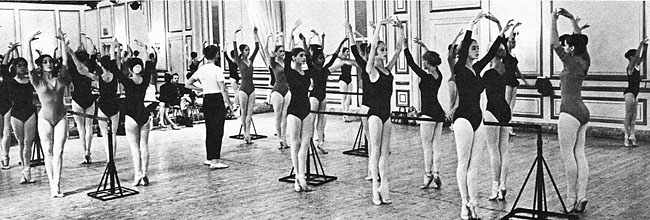
.Photo: Me teaching class at Harkness House studio
La Fille Mal Gardée
An old friend in Bethlehem, Pennsylvania, Alexi Ramov, gave me a
call to see if I could stage “La Fille Mal Gardée” for his company,
“The Lehigh Valley Ballet”.
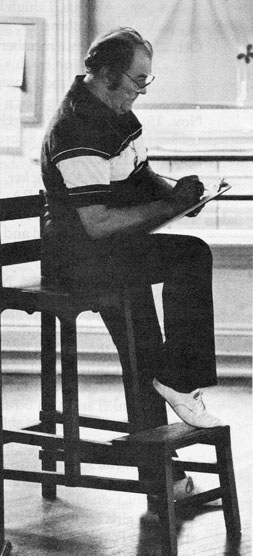 He
was one of the founders of the Northeast Regional Ballet movement,
spearheaded by Doris Herring. I had once auditioned dancers for his
company, back during the Elmira days. He
was one of the founders of the Northeast Regional Ballet movement,
spearheaded by Doris Herring. I had once auditioned dancers for his
company, back during the Elmira days.
Photo: Alexi Ramov
I had of course seen Sir Frederic Ashton’s ‘Fille’ many times in
London. It was one of my favorite works of his. At the Benesh
Institute we had studied its choreography and how it was put
together, even learned some of the dances. Naturally, I wouldn’t be
able to stage that version without permission from Ashton. As I had
done with the “Cinderella” at Butler, I used the basic concept and
inserted into it my own choreography.
The ballet tells the story of the ‘unchaperoned daughter’ of a
widowed, rural mother who wishes her to marry an ungainly, country
bumpkin for wealth rather than love. The daughter, Lisa, is wildly
in love with another, Colas, and they are together at every possible
moment, much to the mother’s chagrin.
It is a wonderful vehicle to introduce ballet to the uninitiated.
There is as much acting as there is dancing, and a thread of humor
and slapstick comedy weaves its way through the entire ballet. When
the predictable happy ending unites the two lovers, there is one
more chuckle the audience can take along with them.
The company rented the scenery for the two acts from the Boston
Ballet production. When it arrived there were no instructions as to
how the wagon was put together. The spinning wheel and the maypole
also had no directions. We got by without the wagon, even though we
had the donkey to pull it, but the loosely put together maypole at
the end of Act One, started to topple over during opening night’s
performance and the Widow’s spinning wheel in Act two took some
maneuvering to make it work
It was a student company, but mixed with professionals. A local girl
danced Lisa, who later went on to dance it with the Joffrey Ballet.
Michael Haubrich, a graduate of SAB, (School Of American Ballet)
danced the role of Colas and Peter Degnan, another local, was Alain,
the simpleton.
The Widow Simone is traditionally and always danced comically by
a man. His hilarious clog dance is very appealing to audiences and
always gets a huge applause. A young man living in nearby Allentown
was anxious to do it. Unfortunately, two days before the opening he
came down with hepatitis. Nobody had thought of double-casting the
ballet so there was no one to replace him. The performance could
certainly not go on without this most prominent role so it was left
to me to step in and do it. It was the first time I’d ever danced a
travesty role, or as the French say, en travestie. It is very common
in Europe for men to perform on the stage as grotesque women.
The costume, designed after the one worn in the Royal Ballet
version, seemed a good fit. Also the wig. I had to forgo my role as
director of the production in order to have time to rehearse myself.
The clog dance was really the only actual dance I had to do, the
rest was all acting. Having rehearsed the other fellow in the role
for months, I knew it well and had no trouble performing it, along
with the false trips, slides, prat falls and general buffoonery.
Review of La Fille Mal Gardée
“ …. The production was blessed with two outstanding performances by
Peter Degnan, who played Alain, the oafish young suitor, and Richard
Holden, who choreographed the ballet and stepped in at the last
minute to replace an ailing Michael Henick as the Widow Simone,
Lise’s mother.
These two professionals left no doubt about their talent. Degnan,
….. clowned the part of Alain to perfection while performing the
dance portion brilliantly.
Holden, a seasoned dancer, choreographer, teacher, lecturer and
author, mimed to perfection the fussy and protective mother. It was
a shock to some in the audience when he whipped off his wig at the
final curtain ….”
The Globe-Times, Bethlehem , PA, April 26, 1983
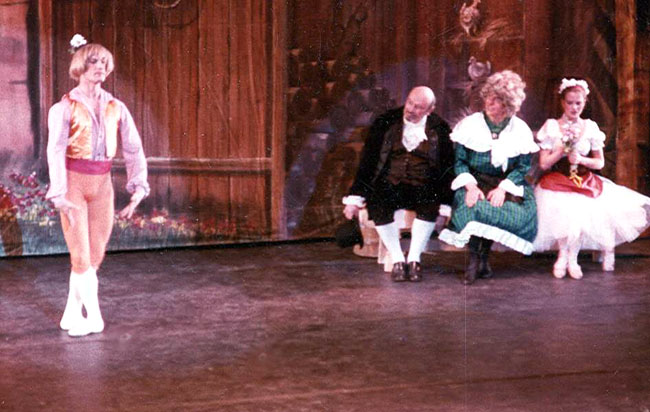 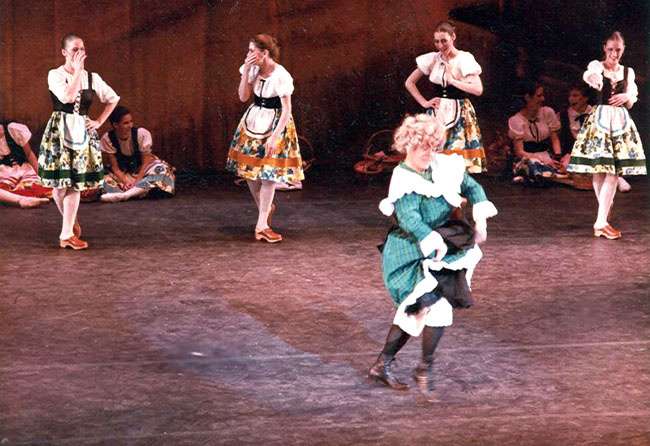 |
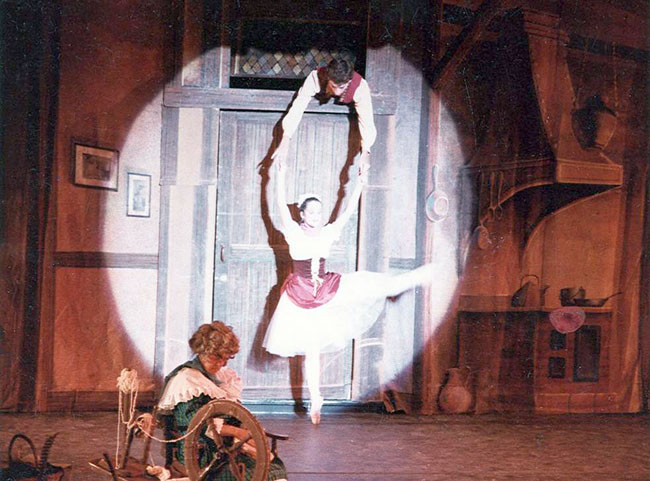 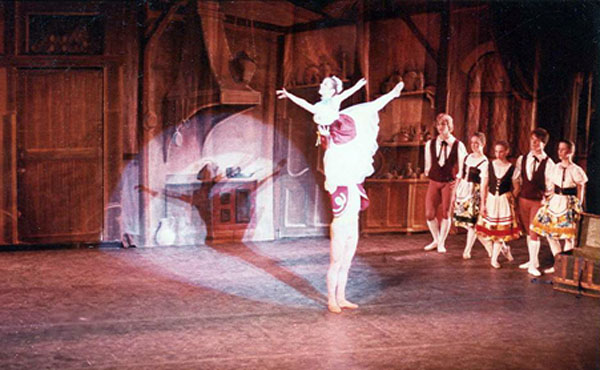
Photos from this 1983 La Fille Mal Gardée production. Me
in the comic Widow Simone role. |
|

Graduation Ball in Westchester
At the same time I was rehearsing “Graduation Ball” for a
company in Westchester, NY, run by another former Ballet
Russe dancer and friend, Rose Marie Menes. I already knew
Grad Ball from the Memphis staging.
The character of the Head Mistress of the girl’s seminary
in Grad Ball is another comic role, which is always danced
by a man as an absurd and bustling busybody. Again, it ended
with no one around who could do it. Having just finished
doing the Widow Simone, I was coaxed into taking over the
Head Mistress role as well. This called for a lot of acting
as well as a strenuous mazurka, performed with the pompous
old General. I studied lots of films of Danny Kaye and his
slap-stick comedy routines for this role.
Photo: Me as the Head Mistress in Graduation Ball
|
|
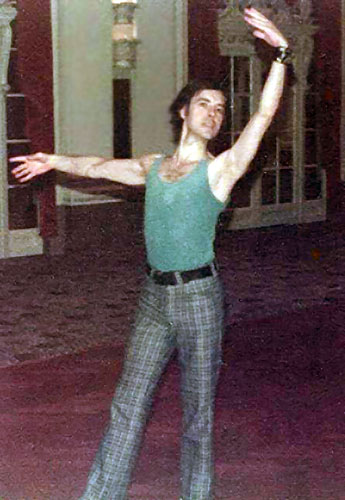 Teacher
conventions seemed to be a calling card for me. With the
experience of the previous ones, I’d learned more precisely
what was expected of me. There were also regular visits to
Columbus, Ohio to choreograph for a small student company. I
used one of Mrs. Harkness’ arrangements of the Schubert
Variations for my “Rondo Brillante” that I staged there,
along with my “Theme Of Youth” and “Peter And The Wolf”. It
was a busy time. Teacher
conventions seemed to be a calling card for me. With the
experience of the previous ones, I’d learned more precisely
what was expected of me. There were also regular visits to
Columbus, Ohio to choreograph for a small student company. I
used one of Mrs. Harkness’ arrangements of the Schubert
Variations for my “Rondo Brillante” that I staged there,
along with my “Theme Of Youth” and “Peter And The Wolf”. It
was a busy time.
Photo: Another teacher’s convention at the NY Biltmore
Ballroom |
Balletfore, “Le Carnaval”
There was a small professional company of nine dancers just starting
up out of Manhattan, led by Diane Byer called “Balletfore”. They
wanted Fokine’s “Le Carnaval” plus something to go with it. I
suggested the pas de deux from “Firebird”, also by Mikhail Fokine.
After a few rehearsals, Diana decided, why not go all the way and do
my entire “Firebird”. Both of these ballets, along with “Les
Sylphides” and “Spectre de la Rose”, staged by myself, were
premiered by this young company at Riverside Theater in Manhattan as
an all-Fokine program.
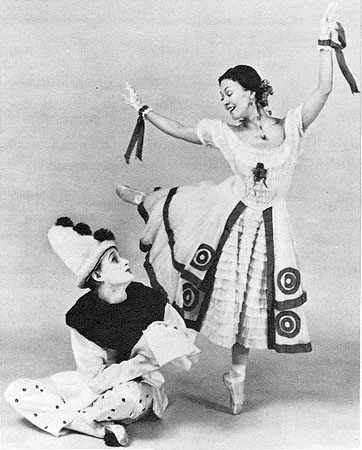 “….
Richard Holden’s staging (of Carnaval) was brisk and charmingly
caught the “powerful passions” of the moment ….. re-creation was
quite delightful and I’m sure the performance reflected the results
of much painstaking effort and research …” “….
Richard Holden’s staging (of Carnaval) was brisk and charmingly
caught the “powerful passions” of the moment ….. re-creation was
quite delightful and I’m sure the performance reflected the results
of much painstaking effort and research …”
Ellen Cornfield, Attitude Magazine
Photo: Sylvia Nolan and Peter Lewton-Brain in this 1984
production of Le Carnaval
“ …. choreographed by Richard Holden ‘In the style of Fokine”. This
interpretation is a work simple and serious, holy and profane, shot
through with mysterious significance. Stravinsky’s score and the
startling costumes inspired by Bakst, plant the work firmly in its
period, but it’s the sureness of the performances .. that make us
believe the fantastic events transpiring on the stage”.
Elizabeth Zimmer, NY Village Voice
“ …. A definite highlight of Firebird was Richard Holden’s staging
of the monster scene. With only one monster and a Petrushka-like
helper, the scene was sparked with tension, apprehension, and humor.
Without qualification the choreography was brilliant. Michael Keith
as the monster and Alexandrous Ballard as the helper made an
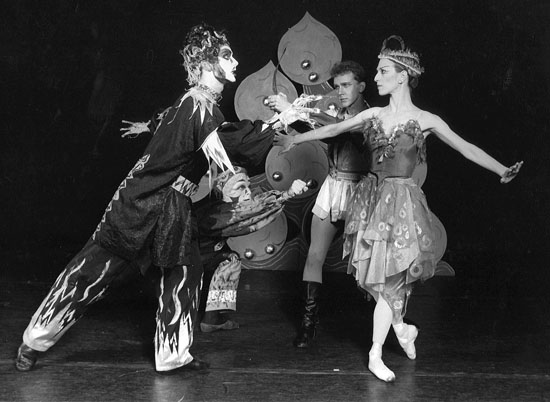 excellent Laurel and Hardy team and completely caught the spirit of
their respective roles. Firebird was a winner …. it was exciting,
well staged, and the story line was easy to follow. It made sense!
With a reduced company and much imagination, Mr. Holden succinctly
re-created the Russian fairy tale …. ….” excellent Laurel and Hardy team and completely caught the spirit of
their respective roles. Firebird was a winner …. it was exciting,
well staged, and the story line was easy to follow. It made sense!
With a reduced company and much imagination, Mr. Holden succinctly
re-created the Russian fairy tale …. ….”
Larry Stevens, Attitude Magazine, 1984
Photo from this 1984 Firebird production
“……. Because the Balletfore production was a shortened one that used
fewer dancers than those of the big companies, it lacked the
grandeur associated with this ballet. But the cuts actually gave the
plot a dramatic urgency while the streamlined approach gave it
easier for the viewer to concentrate on the character development
and on how the movement visualized the music”.
Georgette Couvelia, Yonkers, NY, Westchester Newspapers, March 27,
1984
Mikhail Fokine, was one of the greatest choreographers to come out
of Russia.
He worked for Diaghilev’s company, choreographing “Spectre” and
“Petrushka” for Nijinsky, among many others. When he came to America
during the 1930s , he lived and opened a school on Riverside Drive
in Manhattan. George Chaffee, my first proper teacher had studied
with him there. After a robbery, Fokine moved to Yonkers, NY, a
smaller city along the Hudson River.
This was where Balletfore debuted the all-Fokine program In 1985,
before going on tour,. Some of Fokine’s relatives were still living
there but unfortunately, knew or cared little for ballet, or the
works that their famous relative had created. Nevertheless, the
local papers made quite a thing out of it.
With the success of “Firebird”, Balletfore changed its name to
“New York Theater Ballet” and came under Columbia Artists
Management. They toured my “Firebird” all over the USA and to
Europe.
A New Jersey Nutcracker that lasted 18 years.
Sally Topham, who was a classmate of mine at the Ballet Theater
school during the early 50s.
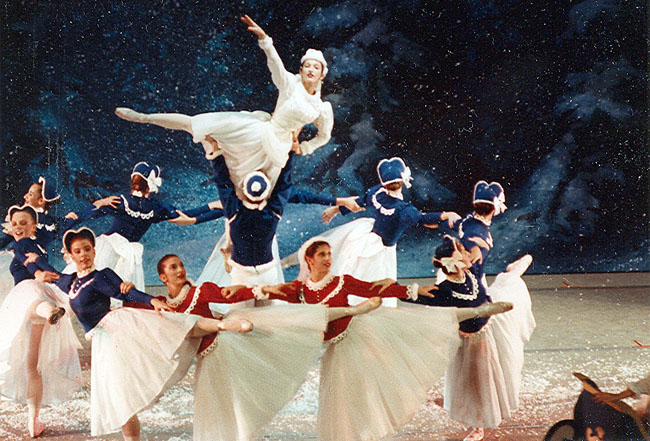 She turned up again in 1984 with her
own company in New Jersey and wanted me to help stage a
“Nutcracker”. She choreographed the first act up until the Snow
scene. From there on it was my choreography. The production went on
for the following eighteen years, as well as “Le Carnaval”,
“Firebird” and a full-length “Cinderella” that I staged for her,
until she sold her company in 2002. She turned up again in 1984 with her
own company in New Jersey and wanted me to help stage a
“Nutcracker”. She choreographed the first act up until the Snow
scene. From there on it was my choreography. The production went on
for the following eighteen years, as well as “Le Carnaval”,
“Firebird” and a full-length “Cinderella” that I staged for her,
until she sold her company in 2002.
Photo: Snow Scene from this Nutcracker production
Le Villi
The New York Grand Opera, a well-established company giving free
outdoor performances in Central Park, was doing Puccini’s “Le Villi”,
(the Willis). Not only from my Met experience but from early on, I
always had a handle on opera-ballet, so was delighted when asked to
choreograph this.
Le Villi, or “The Willis” is not just an opera with a ballet
thrown in. It has ballet and character dancing throughout.
Basically, it’s a ballet-opera, very much like the romantic ballet,
“Giselle”, except Albrecht is a tenor and Giselle a soprano.
I used the New York Theater Ballet dancers and also had to stage
the leading singers through their actions that had to be worked into
the ballet.
There were tremendous sets overflowing the park’s band shell and
a full orchestra in the pit. The singers were all professional and
semi-professional. As it was free, it drew an audience of thousands.
All seats were filled and thousands more standing. My dancers
performed it even better than most of the Metropolitan Opera dancers
could have.
A Colonial Nutcracker
While choreographing and staging these works, I was appearing every
Winter in a “Colonial Nutcracker” as Drosselmeyer, but with a
difference. Since it was set during the Colonial period of early
America, the
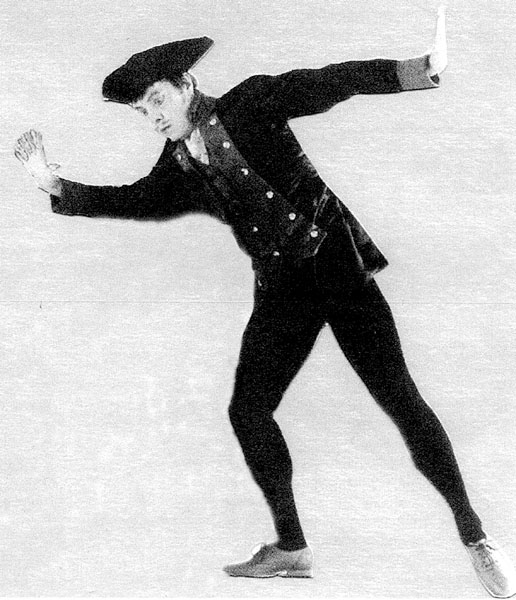 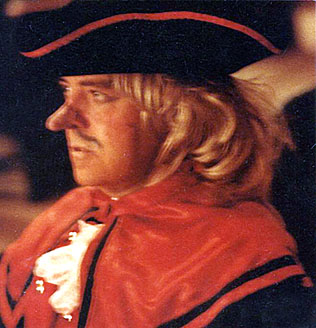 character was changed quite differently. I was costumed
more like George Washington. Instead of a mice battle it was
replaced by British red-coats and Minute Men.
This started a trend in regionalizing Nutcrackers all over. character was changed quite differently. I was costumed
more like George Washington. Instead of a mice battle it was
replaced by British red-coats and Minute Men.
This started a trend in regionalizing Nutcrackers all over.
Photos: Me in the "Colonial" Nutcracker where I was "Samuel
Hinkman" instead of Drosselmeyer. Other traditional Nutcracker
characters were similarly renamed in this adaptation.
At one point I was setting nine ballets for different companies. At
the same time I was writing articles for dance magazines and writing
and illustrating a book on Character Dance, for which Igor
Youskevitch had written a beautiful introduction:
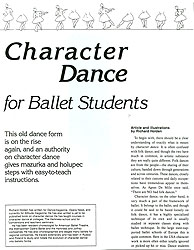 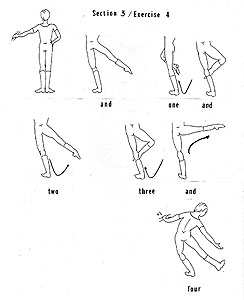 “Mr. Holden’s book on character dance is written for dancers and
dance teachers. It explains well the technique of selected character
dances, and draws proper attention to the importance of expression
and style. No one, of course, can learn to dance by reading a book,
because the information presented must always be interpreted and
physically demonstrated by professional dancers. “Mr. Holden’s book on character dance is written for dancers and
dance teachers. It explains well the technique of selected character
dances, and draws proper attention to the importance of expression
and style. No one, of course, can learn to dance by reading a book,
because the information presented must always be interpreted and
physically demonstrated by professional dancers.
However, the historical background of character dance and its
relationship to classical, as outlined by the author, will make this
book rewarding reading for all interested in dance.
In our time, when Art’s indulgence in abstract forms is a
fashion, a book on character dance is welcome indeed. It reminds us
of the origin of dance whose very birth was influenced by the human
spirit that made us move, dance and express”.
Igor Youskevitch
Death Of George Chaffee
In 1984, during a visit to Paris and Versailles, I received word
that George Chaffee had died. Oddly enough, he had just been to
Paris a month before me. He always adored Paris and spoke French
fluently and had just returned to New York.
A few years before, he had lost his studio on Fifty-Sixth Street.
His building as well as many other ballet studios during the 70s
were condemned and the tenants evicted to clear the way for modern
skyscrapers. This was where I had begun his classes after first
arriving in New York from Boston so many years earlier. Poor
Chaffee. He ended up living in a ninth floor, cockroach infested
apartment on Tenth Avenue, known as Hell’s Kitchen. That’s where he
died of a heart attack.
I returned to New York just in time to attend his memorial
service:
"A memorial service for George Chaffee, a ballet dancer, teacher,
author and collector, will be held at 2 P.M. Saturday at the Church
of St. Mary the Virgin, 145 West 46th Street. Mr. Chaffee, a leading
dancer with the Metropolitan Opera Ballet in the 1930's, amassed a
major collection of dance memorabilia and taught dancers including
Alicia Alonso and John Gilpin. He died Oct. 20. The service will
include reminiscences by colleagues."
From the New York Times, Oct 30, 1984
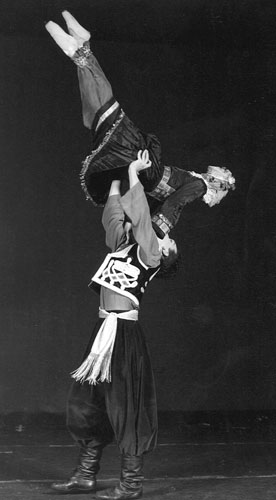 Balletfore, now The New York Theater Ballet, needed some more
choreography. Balletfore, now The New York Theater Ballet, needed some more
choreography.
I had seen the Ashton version of “The Two Pigeons” in the early
60s but could remember none of it except the two live pigeons that
flew into the final scne and the marvelous team of Antonette Sibley
and Christopher Gable. Rather than copy Ashton’s rendering, set in
Paris during La Belle Epoque, I went back to the original libretto
from 1875. I edited the Royal Ballet orchestration by Lanchberry to
make it fit and went to work. In two weeks it was finished I would
choreograph variations and whole sections while on the bus coming
into Manhattan from the Bronx. After its premiere at the Riverside
Festival, Jennifer Dunning gave it a review in the New York Times.
Photo: Gypsy Dance from "Two Pigeons" danced by Diane Byer and
Brian Frette
“The Balletfore choreographers and dancers are good story tellers,
and the stories unfolded with the aid of colorful, inventive sets
and costumes in just the right proportions for the Riverside’s
intimate house and small stage. Mr. Holden succeded in creating a
delicate pastel sketch of a ballet [The Two Pigeons’ with real
period feeling. … the young company’s dancing ahd an extra delicacy
and look of refinement. But this is, even more happily, a company of
dancers who can act, with Mr. Kent and Mr. Michael superb as the
monsters in Mr. Holden’s production of Firebird which completed the
program. Are small-scale revivals of large-scale classics worth
doing? There was evocative magic in these loving recreations that
made the past seem very much alive”.
Jennifery Dunning, THE NEW YORK TIMES, June 9, 1985
Alexander Bennet and La Sylphide
Alexander Bennett, a former principal dancer with the Royal Ballet,
was intensely interested in “La Sylphide”, not the Danish version I
had notated and staged, but the much earlier 1832 French version.
Different music, different choreography. It was his life-long dream
to one day be able to stage it and to write a book about it. His
entire life seemed to be involved in research on it. It was truly
his obsession.
When he once discovered in the British Museum a picture that Queen
Victoria had drawn of La Sylphide while watching a performance at
Covent Garden, it was as if he’d found the Rosetta stone!
When he heard that I had a tape of the music from the original
French version, he made a special visit to me in the Bronx, anxious
to listen to it, and perhaps get a copy.
I had never met him before but was pleased to find he had full
respect for the ballet’s nineteenth century origins and was
delighted to share with him whatever material I had on La Sylphide,
historical or otherwise.
At that time he was teaching in Chatanooga, Tennesee.
“The Humpbacked Horse” makes another appearance
Since the late 60s I had wanted to stage “The Humpbacked Horse”. I
don’t know why this Russian folk ballet appealed to me so much. It
was in a way like Alex Bennet’s fascination with “La Sylphide”. I
had already taught it of course, in 1974 for the Dance Congress and
had notated it then, after years of research. For so many years I
had praised it to my students and friends. Finally came the chance
to actually stage it in New York for Balletfore. Of course they did
not have the facilities to do the complete ballet. Neither did the
Riverside theater where it was put on. I chose only the scene
beginning with Ivan counting the stars. That’s how it started as the
curtain went up. Then the little horse comes on and dances her
variation followed by Ivan’s variation. The Balletfore dancers
executed the Alexander Radunsky choreography almost as if they had
trained at the Bolshoi itself. The fifteen minute excerpt ended with
the variation of the Tsar Maiden leading into the capture and pas de
deux between her and Ivan. Maya Plitsetskaya and Vladimir Vasiliev
were the original cast that I’d seen in Russia, and also in Toronto,
Canada when the Bolshoi gave a different exerpt from it.
The following day Jennifer Dunning wrote in THE NEW YORK TIMES:
“ … The program began on a note of charming delicacy with Richard
Holden’s staging and arrangement of a scene form a version of “The
Little Humpbacked Horse” choreographed by Alexander Radunsky to
music by Rodion Shchedrin. Mr. Holden succeeded in creating a
fairy-tale atmosphere on the unadorned stage. He was helped in this
by Brian Frette, gently innocent as Ivan the Simpleton, and Ms. Byer,
winsome as the little horse who guides Ivan into another, more
exotic world. Ms Posada’s strong, expansive upper torso had an
appropriately Soviet look, but the rest of her had the English
neatness of attack that identifies this company’s style”.
Jennifery Dunning, New York Times, October 18, 1986
My Farewell To New York
In the tenement building where I lived were some very unusual
inhabitants. Below me lived a rather threatening looking man from El
Salvador, with a mass of wild, mangled hair. But he later turned out
to be quite friendly. On my left was an insane man, undoubtedly a
recent release from an asylum. On my
right lived an old Hungarian opera singer. He was alone, friendless
and not at all threatening, but a terrible singer and constantly
vocalizing. Above my head were families of Cambodian immigrants who
were running an illegal factory, keeping me awake all night running
their sewing machines full blast. That’s not to say that I myself
must have also seemed an oddity. Obviously, a choreographer and a
writer didn’t exactly fit in such a place.
Cambodians, newly arrived as immigrants, had actually taken over
the building. I tried to help them as best I could but obviously,
they were never told how to use any kind of modern American devices,
including bathrooms. I often saw them peeing in the hallways. A nice
old Italian couple living across the hallway had daily been
scrubbing the five flights of stairs. Probably for years the woman
had been doing this, just out of desire to live in cleanliness, but
after seeing this she finally gave up in disgust.
But I got on well enough with the other tenants. The Cambodians
even invited me to their Buddhist wedding party of a sixteen-year
old boy to a twelve-year old girl. Nevertheless, it was not a
comfortable existence. Being basically a pragmatist, I had made the
best of it. After all, I’d had plenty of experience living in
squalor, but after seven years living in the Bronx I’d had enough.
So many of my friends had either died or had left New York. I was
approaching sixty. Did I want a future of being remarkably mediocre?
Even with the disastrous setbacks such as I’d gone through at
Butler, things could still be achieved, or had I completely
sabotaged my life? This internal dialog went on almost daily while
strolling through the Botanical Gardens or along the Bronx River
that wended its way through the Gardens. An ancient Colonial mill
still remained on the river bank, with an outdoor restaurant
attached. I often sat there contemplating what to do.
I found water to be a great teacher. It shows us how to move
through the world with grace, ease, determination, and humility. The
Bronx River even had a waterfall nearby the restaurant. I watched
how the river broke at the waterfall, then how it gained energy and
moved on. Like a river, we encounter our own waterfalls. We may fall
hard but we always keep moving on no matter what. Water can inspire
us to not become rigid with fear or cling to what’s familiar. The
river is brave and does not waste time clinging to its past, but
flows on, without looking back. With these parameters, I decided to
move on too, just as the river flows with its twists, turns and
obstacles along the way.
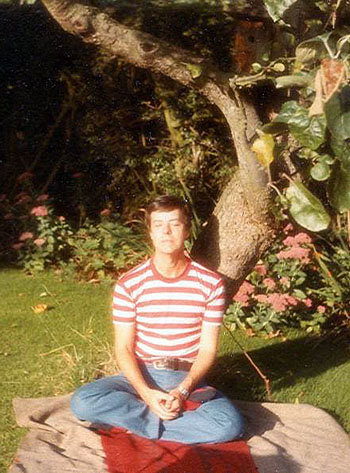
Anticipating change, it seemed like a good time for another visit to
England for further solitude and quiet reflection.
Photo: Meditating in Joyce Harland’s garden in
Buckinghamshire
During those regular leaves of absence from the Met or Harkness to
go to Tucson and choreograph for the Civic Ballet was a time I
always looked forward to. I had fallen in love with the desert and
had told myself then that when I retired it would be to Arizona.
Elizabeth Shaw and her husband were the first to invite me to
Tucson in 1967. Now they were again inviting me to come, this time
to stay.
I idolized the Shaw family because they symbolized the close-nit
clan I never had. They would be my adopted family. |
|
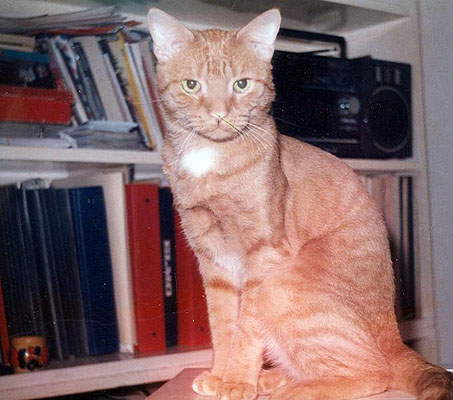 I found a good home for Livingston, my beautiful tabby cat who
had been abandoned in the tenement hallways, and started packing. I found a good home for Livingston, my beautiful tabby cat who
had been abandoned in the tenement hallways, and started packing.
Photo: Livingston, my tabby cat
|
|
|
|
|
Copyright ©2006-2021 OKAY Multimedia |
|
|

 He
was one of the founders of the Northeast Regional Ballet movement,
spearheaded by Doris Herring. I had once auditioned dancers for his
company, back during the Elmira days.
He
was one of the founders of the Northeast Regional Ballet movement,
spearheaded by Doris Herring. I had once auditioned dancers for his
company, back during the Elmira days.




 Teacher
conventions seemed to be a calling card for me. With the
experience of the previous ones, I’d learned more precisely
what was expected of me. There were also regular visits to
Columbus, Ohio to choreograph for a small student company. I
used one of Mrs. Harkness’ arrangements of the Schubert
Variations for my “Rondo Brillante” that I staged there,
along with my “Theme Of Youth” and “Peter And The Wolf”. It
was a busy time.
Teacher
conventions seemed to be a calling card for me. With the
experience of the previous ones, I’d learned more precisely
what was expected of me. There were also regular visits to
Columbus, Ohio to choreograph for a small student company. I
used one of Mrs. Harkness’ arrangements of the Schubert
Variations for my “Rondo Brillante” that I staged there,
along with my “Theme Of Youth” and “Peter And The Wolf”. It
was a busy time. “….
Richard Holden’s staging (of Carnaval) was brisk and charmingly
caught the “powerful passions” of the moment ….. re-creation was
quite delightful and I’m sure the performance reflected the results
of much painstaking effort and research …”
“….
Richard Holden’s staging (of Carnaval) was brisk and charmingly
caught the “powerful passions” of the moment ….. re-creation was
quite delightful and I’m sure the performance reflected the results
of much painstaking effort and research …” excellent Laurel and Hardy team and completely caught the spirit of
their respective roles. Firebird was a winner …. it was exciting,
well staged, and the story line was easy to follow. It made sense!
With a reduced company and much imagination, Mr. Holden succinctly
re-created the Russian fairy tale …. ….”
excellent Laurel and Hardy team and completely caught the spirit of
their respective roles. Firebird was a winner …. it was exciting,
well staged, and the story line was easy to follow. It made sense!
With a reduced company and much imagination, Mr. Holden succinctly
re-created the Russian fairy tale …. ….” She turned up again in 1984 with her
own company in New Jersey and wanted me to help stage a
“Nutcracker”. She choreographed the first act up until the Snow
scene. From there on it was my choreography. The production went on
for the following eighteen years, as well as “Le Carnaval”,
“Firebird” and a full-length “Cinderella” that I staged for her,
until she sold her company in 2002.
She turned up again in 1984 with her
own company in New Jersey and wanted me to help stage a
“Nutcracker”. She choreographed the first act up until the Snow
scene. From there on it was my choreography. The production went on
for the following eighteen years, as well as “Le Carnaval”,
“Firebird” and a full-length “Cinderella” that I staged for her,
until she sold her company in 2002. 
 character was changed quite differently. I was costumed
more like George Washington. Instead of a mice battle it was
replaced by British red-coats and Minute Men.
This started a trend in regionalizing Nutcrackers all over.
character was changed quite differently. I was costumed
more like George Washington. Instead of a mice battle it was
replaced by British red-coats and Minute Men.
This started a trend in regionalizing Nutcrackers all over. 
 “Mr. Holden’s book on character dance is written for dancers and
dance teachers. It explains well the technique of selected character
dances, and draws proper attention to the importance of expression
and style. No one, of course, can learn to dance by reading a book,
because the information presented must always be interpreted and
physically demonstrated by professional dancers.
“Mr. Holden’s book on character dance is written for dancers and
dance teachers. It explains well the technique of selected character
dances, and draws proper attention to the importance of expression
and style. No one, of course, can learn to dance by reading a book,
because the information presented must always be interpreted and
physically demonstrated by professional dancers. Balletfore, now The New York Theater Ballet, needed some more
choreography.
Balletfore, now The New York Theater Ballet, needed some more
choreography.
 I found a good home for Livingston, my beautiful tabby cat who
had been abandoned in the tenement hallways, and started packing.
I found a good home for Livingston, my beautiful tabby cat who
had been abandoned in the tenement hallways, and started packing.